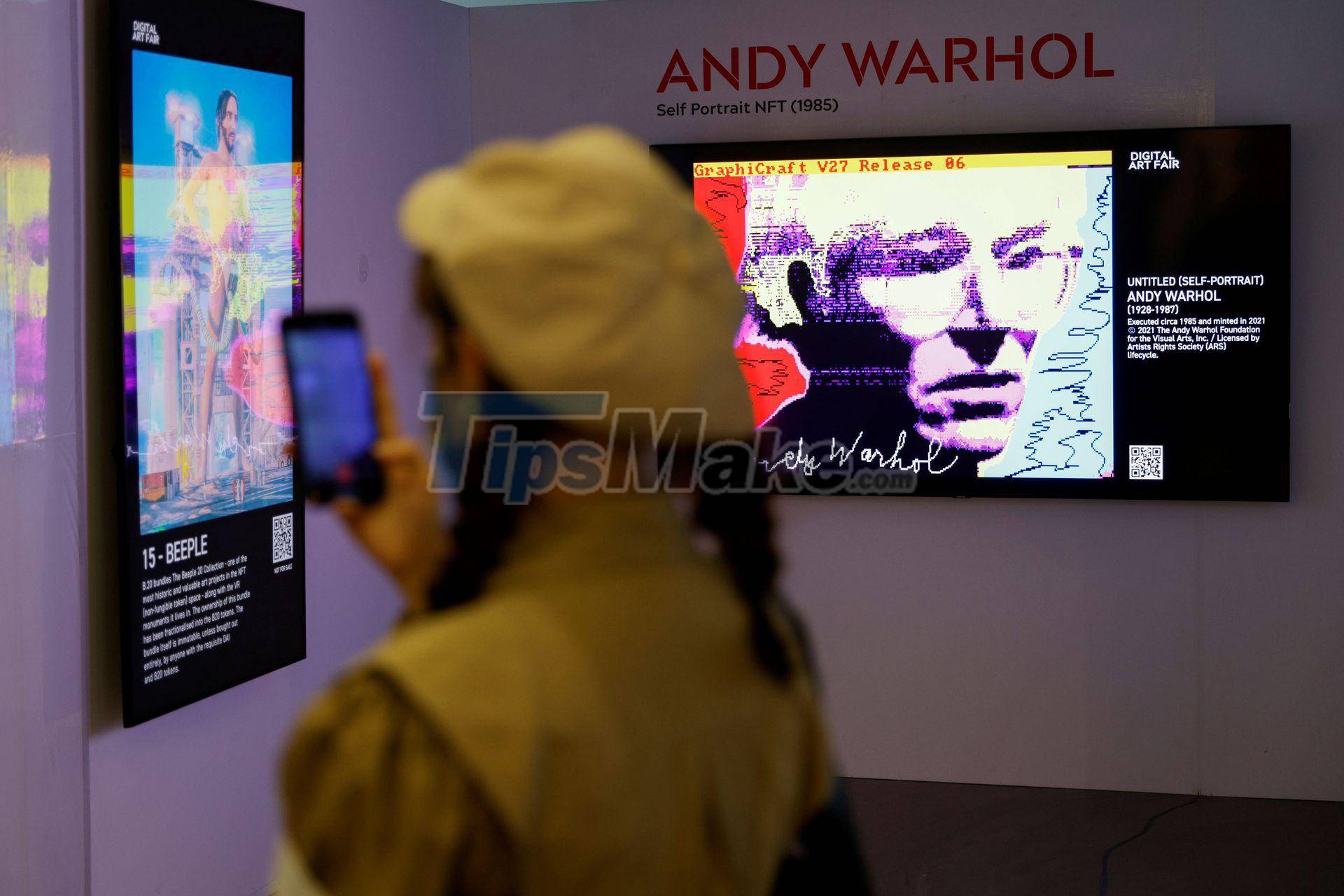Auction houses caught up in the wave of NFT
240 years ago, Christie's auctioned off masterpieces by Rembrandt and Rubens to Catherine the Great, but James Christie wouldn't have expected his auction house to one day offer cartoon ape drawings for him. a cryptocurrency company for over $1 million.

Similarly, Samuel Baker - founder of Sotheby's auction house sold hundreds of rare books for $1,000 in 1744, but he probably couldn't imagine the day Sotheby's sold a copy of the source code of a website below. form of NFT (unique token), worth more than 5 million USD.
Times have changed. "Everybody wants to sell NFTs," said Cassandra Hatton, Sotheby's head of science and popular culture.
In 2021 alone, Sotheby's sold NFTs totaling $65 million, while Christie's earned more than $100 million from NFTs.
According to data from Art Market Research, income from NFT accounts for about 5.5% of contemporary art sales by auction houses, which is not a bad number, considering that NFT is a new trend. bloomed late last year.

Cartoon ape from the Bored Ape Yacht Club collection of 10,000 figures, each with its own value
The people who buy NFT from the auction are mainly a group of customers who got rich on cryptocurrency. In the online NFT auction held in June, which raised $17.1 million, Sotheby's recorded that nearly 70% of auction participants were new customers.
For example, Kosta Kantchev - who runs the virtual currency lending platform Nexo, has just acquired a trio of cartoon ape NFTs for $ 1.3 million in the largest live Christie's auction in Europe since the Covid-19 epidemic. -19 begins.
Antoni Trenchev, who runs Nexo with Kantchev, describes the scene of the auction as follows: "There were people in suits standing at the front, and on the sides, there were people taking anonymous phone calls to bid anonymously. At the end are entrepreneurs and people working in the crypto industry, they don't come here wearing suits."
Market structure changes
The NFT wave has swept hundreds of years old auction houses into a new world. To entice a group of potential customers, they started using social media. Noah Davis - Christie's head of digital art often communicates and negotiates contracts with customers via Discord or Twitter. This is faster than traditional procedures, he told Reuters.
Auctioneers also often source NFTs directly from digital artists, sometimes unknown artists.
"The biggest surprise for me was that artists wanted to work directly with the auction house. We were always in the secondary market," said Rebekah Bowling, an expert on 20th-century art and contemporary art. , working at auction house Phillips said.

Risks from NFT
Auctioneers may face new risks when customers use crypto to buy NFTs. On the other hand, they must also ensure a Know Your Customer (KYC) process to verify customer identity and comply with anti-money laundering (AML) laws.
However, Sotheby's does not disclose their KYC and AML processes. Christie's says the KYC and AML processes it applies to selling NFTs are the same as when selling physical artwork.
Many other problems can arise when owning an NFT. In June of this year, a customer spent $1.5 million to buy an animation called "Quantum", which Sotheby's calls the world's first NFT, which appeared in 2014. But then someone else claimed they owned the original of this NFT before Sotheby's put it up for sale, and demanded compensation from the auction house.
In early July, Sotheby's sold NFT of the World Wide Web source code for $5.4 million, but some people discovered that the animated version of the source code was faulty. However, Sotheby's did not comment on the matter.
Despite many flaws, Pablo Rodriguez-Fraile - an art collector living in Miami (USA) still believes that auction houses are making very active efforts. "They're normalizing the ecosystem, I think soon, they'll find the right path," he said.
You should read it
- Discover inside the planet's largest yacht, it can serve nearly 7,000 passengers
- How to post items on eBay
- 8 things you can do when you feel bored
- How to Create a New Club on Fanpop
- Review : Doki Doki Literature Club - Love and Envy
- Offer Wallpaper Club, the 'no ads' background image app, is free
- How to download Gacha Club on your computer, play Gacha Club on your computer
- TOP mod Doki Doki Literature Club gamers should install
May be interested
- After 40 years of searching, scientists have discovered the type of wave that reveals the secret of the Sun's core
 thanks to this type of wave, scientists have learned that the sun core has a faster rotation speed of 4 times on the surface. this discovery opens a new door for solar physics.
thanks to this type of wave, scientists have learned that the sun core has a faster rotation speed of 4 times on the surface. this discovery opens a new door for solar physics. - Beautiful garden level model 4
 here are beautiful 4-level garden houses, saving construction costs, please refer.
here are beautiful 4-level garden houses, saving construction costs, please refer. - What is Wave Browser? Is it a virus?
 some put speed and convenience first, some focus on privacy, while others can only be used for specialized tasks. and some browsers are potentially malicious, like the wave browser.
some put speed and convenience first, some focus on privacy, while others can only be used for specialized tasks. and some browsers are potentially malicious, like the wave browser. - Model house with nice roofs
 here are the beautiful, modern 4-level houses in many segments of the area and investment costs, please refer to for more ideas for the family's construction plan.
here are the beautiful, modern 4-level houses in many segments of the area and investment costs, please refer to for more ideas for the family's construction plan. - Compare Zigbee and Z-Wave, 2 wireless technologies for smart home
 due to the popularity of home automation products, the number of wireless technologies that allow these devices to 'communicate' with each other has also increased. two of these technologies are zigbee and z-wave.
due to the popularity of home automation products, the number of wireless technologies that allow these devices to 'communicate' with each other has also increased. two of these technologies are zigbee and z-wave. - Level 4-storey house mezzanine 3 bedrooms
 here are some samples of level 4 houses with mezzanine 3 beautiful bedrooms, scientifically designed to bring spacious living space, avoid cramped, please refer.
here are some samples of level 4 houses with mezzanine 3 beautiful bedrooms, scientifically designed to bring spacious living space, avoid cramped, please refer. - The trick that makes iPhone use a bar-line number
 under apple's default settings, the iphone will indicate the strength / weakness of the phone wave with 5 dots at the top left corner of the device. however, if you do not like it, you can apply the procedure below to make iphone replace 5 dots with negative numeric values.
under apple's default settings, the iphone will indicate the strength / weakness of the phone wave with 5 dots at the top left corner of the device. however, if you do not like it, you can apply the procedure below to make iphone replace 5 dots with negative numeric values. - 38 extremely creative design ideas for narrow-sized apartments (Part 2)
 would it be difficult for the daily activities of family members to live in a modest space? let's take a look at 38 extremely creative design ideas below to see that tight houses are not a problem, the problem is how much we can create with that amount of space.
would it be difficult for the daily activities of family members to live in a modest space? let's take a look at 38 extremely creative design ideas below to see that tight houses are not a problem, the problem is how much we can create with that amount of space. - 38 extremely creative design ideas for narrow-sized apartments (Part 1)
 would it be difficult for the daily activities of family members to live in a modest space? let's take a look at 38 extremely creative design ideas below to see that tight houses are not a problem, the problem is how much we can create with that amount of space.
would it be difficult for the daily activities of family members to live in a modest space? let's take a look at 38 extremely creative design ideas below to see that tight houses are not a problem, the problem is how much we can create with that amount of space. - Principles of design stairs for tube houses
 with a tube house with limited horizontal characteristics, the design and construction of stairs must adhere to certain principles to ensure the satisfaction of demand, utility and space saving, creating a harmonious atmosphere. peace for the house.
with a tube house with limited horizontal characteristics, the design and construction of stairs must adhere to certain principles to ensure the satisfaction of demand, utility and space saving, creating a harmonious atmosphere. peace for the house.










 Looking back at the 10 year history of bitcoin
Looking back at the 10 year history of bitcoin The computer made a rudimentary calculation error, the data network caused the Bitcoin price to 'collapse' to $ 5,400
The computer made a rudimentary calculation error, the data network caused the Bitcoin price to 'collapse' to $ 5,400 Why did the Bitcoin price suddenly 'plunge' in the past few days?
Why did the Bitcoin price suddenly 'plunge' in the past few days? What is NFT? new trend based on blockchain technology
What is NFT? new trend based on blockchain technology Cryptocurrency exchange Liquid had $90 million stolen by hackers
Cryptocurrency exchange Liquid had $90 million stolen by hackers From Bitcoin to Dogecoin, both rebounded strongly, the cryptocurrency market exceeded 2 trillion USD in market capitalization
From Bitcoin to Dogecoin, both rebounded strongly, the cryptocurrency market exceeded 2 trillion USD in market capitalization